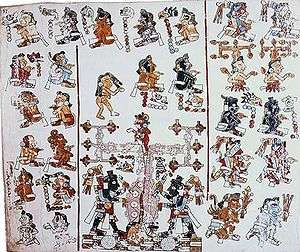Codex Vindobonensis Mexicanus I

Codex Vindobonensis Mexicanus I, also known as Codex Vindobonensis C, or Codex Mexicanus I is an accordion-folded pre-Columbian piece of Mixtec writing. It is a ritual-calendrical and genealogical document dated to the 14th century.
Contents
Codex Vindobonensis has 52 pages with size 26.5 by 22 cm. It was composed in a form of harmony with length 13.5 m. Its weight is 2.687 kg. The text is divided into 10 major sections. In the beginning it presents mythological genealogies of gods. It also contains lists of Mixtecian rulers and priests.
History
It is not certain where the codex was discovered. Probably it was discovered in Veracruz and sent to Sevilla, together with the other manuscript Codex Zouche-Nuttall, as a gift for Charles V in 1519. The later story of the codex is not well known, but it came to Portugal, Rome, Weimar, and Vienna (at last).
The manuscript changed its owners and places in which it was housed. As a result, its name was often changed (18 times). It was known as Codex Constantinopolitanus, Codex Byzantinus, and Codex Mexicanus I. The last name is more often used in the present day.
Currently it is housed at the Austrian National Library at Vienna.
See also
Further reading
- Codex Vindobonensis Mexicanus I: A commentary Institute for Mesoamerican Studies, State University of New York at Albany (1978).
- Walter Lehmann and Ottokar Smital, Codex Vindobonensis Mexicanus 1. Faksimileausgabe der Mexikanischen Bilderhandschrift der Nationalbibliothek in Wien (Vienna, 1929).
External links
- Elizabeth P. Benson, Dumbarton Oaks, Mesoamerican writing systems, Washington 1973
- British Museum: Codex Vienna (facsimile) / Codex Vindobonensis (facsimile) / Codex Vindobonensis Mexicanus 1 (facsimile)